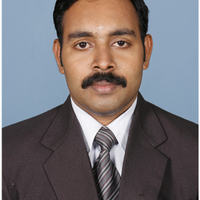Papers by Normand Beaudoin
Canadian Journal of Physics, 2013
Organic electroluminescent devices with an ITO/TPD/Alq3/Al structure are fabricated and tested fo... more Organic electroluminescent devices with an ITO/TPD/Alq3/Al structure are fabricated and tested for their photovoltaic properties. To produce an open-circuit photovoltage, a conditioning is required. Here, the conditioning is exposing the device to air for a short duration. Without this conditioning, the device produces a short-circuit photocurrent with practically no open-circuit photovoltage. Calculations and fits to the photovoltaic data show that this observation could be attributed to the formation of a metal–insulator–semiconductor junction between the Alq3 and the Al, where an insulating layer is created by this conditioning.

Journal of Sol-Gel Science and Technology, Dec 1, 2013
Mesoporous WO 3-TiO 2 composite films were prepared by a sol gel based two stage dip coating meth... more Mesoporous WO 3-TiO 2 composite films were prepared by a sol gel based two stage dip coating method and subsequent annealing at 450, 500 and 600°C. An organically modified silicate based templating strategy was adopted in order to obtain a mesoporous structure. The composite films were prepared on ITO coated glass substrates. The porosity, morphology, and microstructures of the resultant products were characterized by scanning electron microscopy, N 2 adsorption-desorption measurements, l-Raman spectroscopy and X-ray diffraction. Calcination of the films at 450, and 500°C resulted in mixed hexagonal (h) plus monoclinic phases, and pure monoclinic (m) phase of WO 3 , respectively. The degree of crystallization of TiO 2 present in these composite films was not evident. The composite films annealed at 600°C, however, consist of orthorhombic (o) WO 3 and anatase TiO 2. It was found that the o-WO 3 phase was stabilized by nanocrystalline anatase TiO 2. The thus obtained mesoporous WO 3-TiO 2 composite films were dye sensitized and applied for the construction of photochromic devices. The device constructed using dye sensitized WO 3-TiO 2 composite layer heat treated at 600°C showed an optical modulation of 51 % in the NIR region, whereas the devices based on the composite layers heat treated at 450, and 500°C showed only a moderate optical modulation of 24.9, and 38 %, respectively. This remarkable difference in the transmittance response is attributed to nanocrystalline anatase TiO 2 embedded in the orthorhombic WO 3 matrix of the WO 3-TiO 2 composite layer annealed at 600°C.
Optics Communications, Dec 1, 2015
It is generally assumed that changes in optical properties of vanadium dioxide, such as transmitt... more It is generally assumed that changes in optical properties of vanadium dioxide, such as transmittance and reflectance, during phase transition originate from modified refractive indices and interference effects. In this study, we show that up to 50% of losses during phase transition is in fact created by enhanced optical scattering. From simultaneous measurements of diffuse and specular transmission and reflection, a detailed account of scattering losses is obtained. Since optical scattering only increases in the temperature range corresponding to the phase transition, it suggests the growth of metallic islands from nucleation sites may be the underlining scattering mechanism. Optical scattering offers an alternative method to study this important material and could have consequences for some applications such as optical switches and waveguides.

Canadian mathematical bulletin, Dec 9, 2019
Effective and accurate high-degree spline interpolation is still a challenging task in today's ap... more Effective and accurate high-degree spline interpolation is still a challenging task in today's applications. Higher degree spline interpolation is not so commonly used because it requires the knowledge of higher order derivatives at the nodes of a function on a given mesh. In this article, our goal is to demonstrate the continuity of the piecewise polynomials and their derivatives at the connecting points, obtained with a method initially developed by Beaudoin (1998, 2003) and Beauchemin (2003). This new method involving the discrete Fourier transform (DFT/FFT) leads to higher degree spline interpolation for equally spaced data on an interval [0, T ]. To do this, we analyze the singularities that may occur when solving the system of equations that enables the construction of splines of any degree. We also note an important difference between the odd-degree splines and even-degree splines. These results prove that Beaudoin and Beauchemin's method leads to spline interpolation of any degree and that this new method could eventually be used to improve the accuracy of spline interpolation in traditional problems.

Proceedings of SPIE, Mar 1, 1991
ABSTRACT Pulsed photoconduction study of Al/Chlorophyll (alpha) /Al sandwich cells has been carri... more ABSTRACT Pulsed photoconduction study of Al/Chlorophyll (alpha) /Al sandwich cells has been carried out in order to investigate the charge transport in chlorophyll (alpha) (CHl (alpha) ). The charge carriers are generated close to the electrode by laser pulse (800 ps) of strongly absorbed wavelength 750 nm by Chl (alpha) . The results suggest that the trapping of photogenerated charge carriers is quite significant. The electron transient current is practically absent, and the hole current signal rapidly decreases due to deep trapping. The signal shows a biexponential behavior in time period of approximately 50 microsecond(s) which could be related to the presence of two trapping species. In millisecond time range, the hole current shows a long tail in addition to the fast component. The analysis of the long tail seems to suggest the addition to the fast component. The analysis of the long tail seems to suggest the dispersive hole transport phenomenon in microcrystalline Chl (alpha) .

Biophysical Journal, 1996
In purple membrane added with general anesthetics, there exists an acid-base equilibrium between ... more In purple membrane added with general anesthetics, there exists an acid-base equilibrium between two spectral forms of the pigment: bR570 and bR480 (apparent pKa = 7.3). As the purple 570 nm bacteriorhodopsin is reversibly transformed into its red 480 nm form, the proton pumping capability of the pigment reversibly decreases, as indicated by transient proton release measurements and proton translocation action spectra of mixture of both spectral forms. It happens in spite of a complete photochemical activity in bR480 that is mostly characterized by fast deprotonation and slow reprotonation steps and which, under continuous illumination, bleaches with a yield comparable to that of bR570. This modified photochemical activity has a correlated specific photoelectrical counterpart: a faster proton extrusion current and a slower reprotonation current. The relative areas of all photocurrent phases are reduced in bR480, most likely because its photochemistry is accompanied by charge movements for shorter distances than in the native pigment, reflecting a reversible inhibition of the pumping activity.
Applied Numerical Mathematics
Object recognition supported by user interaction for service robots

Canadian Journal of Physics, 1998
From few simple and relatively well-known mathematical tools, an easily understandable, though po... more From few simple and relatively well-known mathematical tools, an easily understandable, though powerful, method has been devised that gives many useful results about numerical functions. With mere Taylor expansions, Dirac delta functions and Fourier transform with its discrete counterpart, the DFT, we can obtain, from a digitized function, its integral between any limits, its Fourier transform without band limitations and its derivatives of any order. The same method intrinsically produces polynomial splines of any order and automatically generates the best possible end conditions. For a given digitized function, procedures to determine the optimum parameters of the method are presented. The way the method is structured makes it easy to estimate fairly accurately the error for any result obtained. Tests conducted on nontrivial numerical functions show that relative as well as absolute errors can be much smaller than 10-100, and there is no indication that even better results could n...
Ces changements du spectre d'absorption du pigment révèlent des modifications des interactions pr... more Ces changements du spectre d'absorption du pigment révèlent des modifications des interactions protéine-chromophore et cachent peut-être des modifications mesurables de la structure de la bactériorhodopsine. préférable. li demeurera toujours possible, après coup de lisser ce résultat, de le filtrer ou de lui ajuster une fonction appropriée. Une telle méthode existe; il s'agit de la déconvolution directe par transformée de Fourier. En toute rigueur, il faut dire que calculer la transformée de Fourier d' une fonction revient for Fourier transform, integral, deriuatiues and polynomial splines of any order
Lecture Notes in Computer Science, 2003
The classical method of numerically computing Fourier transforms of digitized functions in one or... more The classical method of numerically computing Fourier transforms of digitized functions in one or in d-dimensions is the so-called Discrete Fourier Transform (DFT) efficiently implemented as Fast Fourier Transform (FFT) algorithms. In many cases, the DFT is not an adequate approximation of the continuous Fourier transform. Because the DFT is periodical, spectrum aliasing may occur. The method presented in this

Journal of Sol-Gel Science and Technology, 2013
Mesoporous WO 3 -TiO 2 composite films were prepared by a sol gel based two stage dip coating met... more Mesoporous WO 3 -TiO 2 composite films were prepared by a sol gel based two stage dip coating method and subsequent annealing at 450, 500 and 600°C. An organically modified silicate based templating strategy was adopted in order to obtain a mesoporous structure. The composite films were prepared on ITO coated glass substrates. The porosity, morphology, and microstructures of the resultant products were characterized by scanning electron microscopy, N 2 adsorption-desorption measurements, l-Raman spectroscopy and X-ray diffraction. Calcination of the films at 450, and 500°C resulted in mixed hexagonal (h) plus monoclinic phases, and pure monoclinic (m) phase of WO 3 , respectively. The degree of crystallization of TiO 2 present in these composite films was not evident. The composite films annealed at 600°C, however, consist of orthorhombic (o) WO 3 and anatase TiO 2 . It was found that the o-WO 3 phase was stabilized by nanocrystalline anatase TiO 2 . The thus obtained mesoporous WO 3 -TiO 2 composite films were dye sensitized and applied for the construction of photochromic devices. The device constructed using dye sensitized WO 3 -TiO 2 composite layer heat treated at 600°C showed an optical modulation of 51 % in the NIR region, whereas the devices based on the composite layers heat treated at 450, and 500°C showed only a moderate optical modulation of 24.9, and 38 %, respectively. This remarkable difference in the transmittance response is attributed to nanocrystalline anatase TiO 2 embedded in the orthorhombic WO 3 matrix of the WO 3 -TiO 2 composite layer annealed at 600°C.
Journal of Materials Chemistry, 2011
... Chem. Soc., 2001, 123, 10639 Article ChemPort . 16, Y. Djaoued, S. Priya and S. Balaji, J. No... more ... Chem. Soc., 2001, 123, 10639 Article ChemPort . 16, Y. Djaoued, S. Priya and S. Balaji, J. Non-Cryst. Solids, 2008, 354, 673 . 17, A. Hauch, A. Georg, S. Baumgaertner, UO Kraovec and B. Orel, Electrochim. Acta, 2001, 46, 2131 Article ChemPort . ...
Applied Physics Letters, 2005
[Applied Physics Letters 87, 101907 (2005)]. Abdellatif Gherabi, Normand Beaudoin, Serge Gauvin. ... more [Applied Physics Letters 87, 101907 (2005)]. Abdellatif Gherabi, Normand Beaudoin, Serge Gauvin. Abstract. ... Phys. 81, 6954 (1997). JCScott, S.Karg, and SACarter, Bipolar charge and current distributions in organic light-emitting diodes, J. Appl. Phys. 82, 1454 (1997). ...
Frontiers in Optics 2014, 2014
Nonlinear Optics and Applications VII, 2013
Review of Scientific Instruments, 2006
[Review of Scientific Instruments 77, 026102 (2006)]. Normand Beaudoin, Sophie Essiambre, Serge G... more [Review of Scientific Instruments 77, 026102 (2006)]. Normand Beaudoin, Sophie Essiambre, Serge Gauvin. Abstract. ... References. F.Cacialli, RHFriend, SCMoratti, and ABHolmes, Synth. Met. 67, 157 (1994). DRBaigent, PGMay, and RHFriend, Synth. Met. 76, 149 (1996). ...

IEEE Transactions on Signal Processing, 2003
The classical method of numerically computing Fourier transforms of digitized functions in one or... more The classical method of numerically computing Fourier transforms of digitized functions in one or in -dimensions is the so-called discrete Fourier transform (DFT) efficiently implemented as fast Fourier transform (FFT) algorithms. In many cases, the DFT is not an adequate approximation to the continuous Fourier transform, and because the DFT is periodical, spectrum aliasing may occur. The method presented in this contribution provides accurate approximations of the continuous Fourier transform with similar time complexity. The assumption of signal periodicity is no longer posed and allows the computation of numerical Fourier transforms in a broader domain of frequency than the usual half-period of the DFT. In addition, this method yields accurate numerical derivatives of any order and polynomial splines of any odd degree. The numerical error on results is easily estimated. The method is developed in one and in dimensions, and numerical examples are presented.

Photochemistry and Photobiology, 1988
Abstract— The absorption maximum of bacteriorhodopsin is shifted from 568 nm to 480 nm when halog... more Abstract— The absorption maximum of bacteriorhodopsin is shifted from 568 nm to 480 nm when halogenated volatile anesthetics (enflurane; halothane) are added to purple membranes. Analysis of the rate of formation of this new species upon addition of the anesthetic and of the back-formation of native bacteriorhodopsin upon its removal indicate that in purple membranes, the dark-adapted chromophore is much less reactive than its light-adapted counterpart. Lipid-soluble molecules thus have a lower accessibility to the dark-adapted chromophore.In addition, activity of the 480 nm bacteriorhodopsin was investigated. Flash and steady-state photolysis experiments reveal that this blue shifted chromophore has full photochemical activity. It has a meta-intermediate absorbing maximally at 380 nm. The photocycle ofBR–480 is mainly characterized by a slow decay of the “O” intermediate, enabling the direct observation of the branching reaction between the “M” intermediate and the parentBR–480 pigment.











Uploads
Papers by Normand Beaudoin